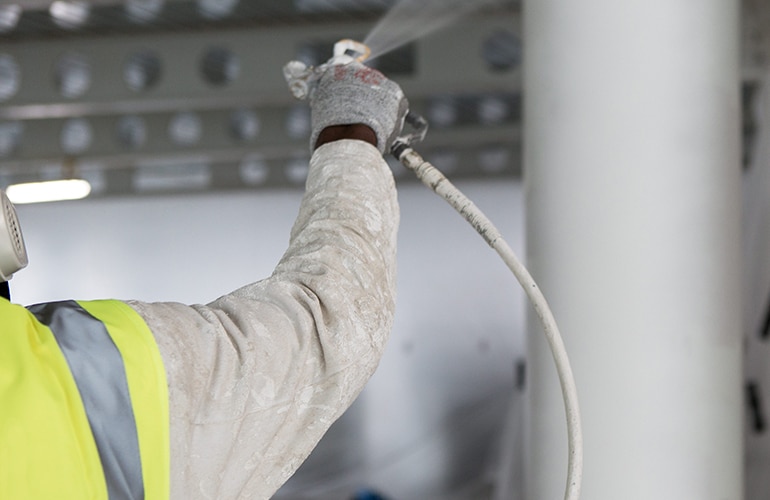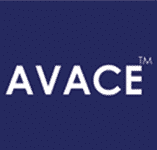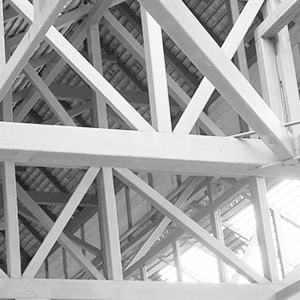How to Protect Steel Structures with Steelmaster Intumescent Paint.
Why is Intumescent Paint Specified on Steel?
In a fire it is critical that the structural frame of the building is protected correctly so that the materials do not reach their critical failure temperature, potentially causing the building to collapse. Intumescent paint not only prevents this from happening, but it slows down the spread of a fire, giving more time to evacuate buildings safely saving lives.
Intumescent paints are referred to as Reactive Paints, once they are subjected to temperatures exceeding 120°C, the paint will intumesce swelling up to 50 times the original thickness of the paint, forming a carbon layer which thermally insulates the material for a given period of time. This is typically 30, 60, 90, 120 or 180 minutes.
This protection is compulsory to comply with the building regulations set out in England and Wales which outlines the legal obligations for building designers.
Building Regulations
The building regulations contain functional requirements that outline what must be done. An example of a requirement that covers structural steel in a fire is "the building shall be designed and constructed so that, in the event of a fire, it's stability will be maintained for a reasonable period".
According to Approved Document B the reasonable period for structural fire resistance may vary between 30, 60 and 90 minutes according to the occupancy and the height of the building. Requirements change at 5, 18 and 30 meters IN height. For example, an office that is less than 18m tall must maintain structural stability for 60 minutes during a fire. This can be reduced by 30 minutes if a sprinkler is installed.
British Standard 9999: the Code of Practice for Fire Safety in the Design, Management and Use of Buildings, seeks to allow the development of solutions based on an understanding of the causes of risk to life and how these can be mitigated.
This standard classifies buildings according to a risk profile based on occupancy, fire growth rate, ventilation conditions and building height. It also introduces a new height category for buildings taller than 60m and generally allows more attractive trade-offs for automatic sprinklers installation and automatic fire detection.
During a fire it can just take a few minutes for the temperature of unprotected steel work to reach 550°C. At this point steelwork loses its structural load bearing capacity and can buckle causing a building to potentially collapse. By correctly protecting steel, it exists in a state of Elasticity which allows the steel to bend/deflect and return to its original state once the force has been removed.
Generally intumescent paints will need to comply with EN1364, EN1634 or BS476 Parts 20-23.
You can read more on building standards for steel here.
What are fire retardant paints?
When these are applied to combustible surfaces, such as timber, it will make them much more difficult to ignite to the point where some small fires can self-extinguish. Once a surface has caught fire, the rate of the flame spread will be much slower as well as reduce the phenomenon of flash-over in confined space.
Generally, these types of coatings need to comply with either BS476 parts 6 & 7 or EN13501-1 which are both accepted under part B of the building regulations. However, these types of paints are not Intumescent paints and will not meet the building regulation standards for structural steel.
In contrast Intumescent paints create a barrier against fire by forming a foaming char layer above substrates such as steel. Chemicals within the coating react to heat by creating bubbles of inert gas which are strengthened by both the paint's own polymer and additives. This none-combustible meringue type layer insulates the substrate and increases the time it takes for the fire to penetrate through. In the case of steelwork, this insulation keeps the metal cool for longer, extending the time it takes to collapse.
Independent Testing and Certification.
Intumescent Paints such as Steelmaster 600WF and Steelmaster 1200WF are independently tested and certified by Warrington Fire, Its primary role is to help make certain that the materials, products and processes that they test, inspect and certify for their customers are safe, compliant and fit for purpose.
Warrington Fire offers a Fire Resistance Testing service which tests passive fire protection products for both commercial and domestic building types. This fire resistance testing is done across the construction, furniture, marine and rail sectors and they specialize in testing passive fire protection products including fire doors, fire stopping products and large-scale testing of cladding.
Fire resistance is determined through destructive fire testing designed to replicate the product's intended end use. The specimen to be tested is built into an appropriate supporting construction which is then built into a restraint frame and mounted on the front of a furnace. The temperature within the furnace is controlled according to an internationally accepted time temperature regime.
Steelmaster 600WF
This Intumescent paint is formulated to provide up to 90 minutes fire protection on steel. It is designed for high performance and minimum environmental impact; it has a low odour finish with high coverage rates and lower paint requirements compared to other Intumescents.
Steelmaster 600WF is a single pack high solids waterborne thin film intumescent suitable for structural steel, beams and columns exposed to cellulosic fire. It is ideal for the protection of steel buildings for 30 minutes, 60 minutes and 90 minutes against fire.
Steelmaster 1200WF
This Intumescent paint is a single pack, high solids, waterborne Intumescent coating and is the ultimate in fire protection paints, it is certified and approved for 3 hours fire protection on structural steel. It can be used as a mid-coat or finish coat in atmospheric environments.
Some structures and buildings contain hollow steel sections or lightweight steel columns. These structures will rapidly heat up in a cellulosic fire and need greater protection. Steelmaster 1200WF is designed for hollow and lightweight sections. It can also be used on sections requiring only 60-90 minutes fire rating, reducing the amount of paint required compared to other Intumescents. Often both Steelmaster 600WF and Steelmaster 1200WF will be used on a project to protect a range of different weight columns and beams.
Loading Calculations and Paint Estimates:
The required film thickness will depend on two factors, the physical dimensions of the steel structures and the hourly rating required. Heavier gauge steel will heat up slowly and will require less Steelmaster paint. AVACE provides a free estimation service, if you send us the drawings for your steel project with the quantities and rating required, we will calculate the Steelmaster requirements for each section. Reports are normally completed within a few days.
How to Apply Steelmaster

It is important that drying times are adhered to before application of a second or third coat to ensure thorough drying. It is recommended a wet film gauge is used to measure the thickness of each coat of paint.
Do I need a primer and topcoat?
Intumescent paints generally do not contain any anticorrosive pigments so the steel structures should be primed. For steel in corrosive classifications up to C3, Pilot QD is recommended as it is a fast-air-drying zinc phosphate primer. Ideally the steel structures should be abrasive blast cleaned prior to application of the primer. For more aggressive environments classified C4 or C5-M, a two-pack epoxy zinc phosphate like Penguard HSP ZP is recommended.
Not all projects require a topcoat, however if the steel is external or internal in a high moisture environment then a topcoat is recommended. Topcoats may also be used for decorative purposes to provide colour and gloss. For a matt finish Conseal TU is recommended or Pioner Topcoat for a semigloss finish. All the primers and topcoats have been independently tested by Warrington Fire Research and form part of the approved system.
The Environmental Choice
Steelmaster contributes to Green Building Standard Credits by meeting the requirements of LEED and BREEAM and contains no substances listed in the REACH regulations. It has been used on a large number of large international projects including Cairo and Kuala Lumpur International Airports, Dubai Metro Station, Abu Dhabi GCAA Navigation Centre and Selfridges Birmingham.
AVACE offers free next day delivery on all Steelmaster products, approved primers and topcoats.
For Inspirational Colours and ideas on interior and exterior design, head over to Avacedesign on Instagram for top decorating tips.




